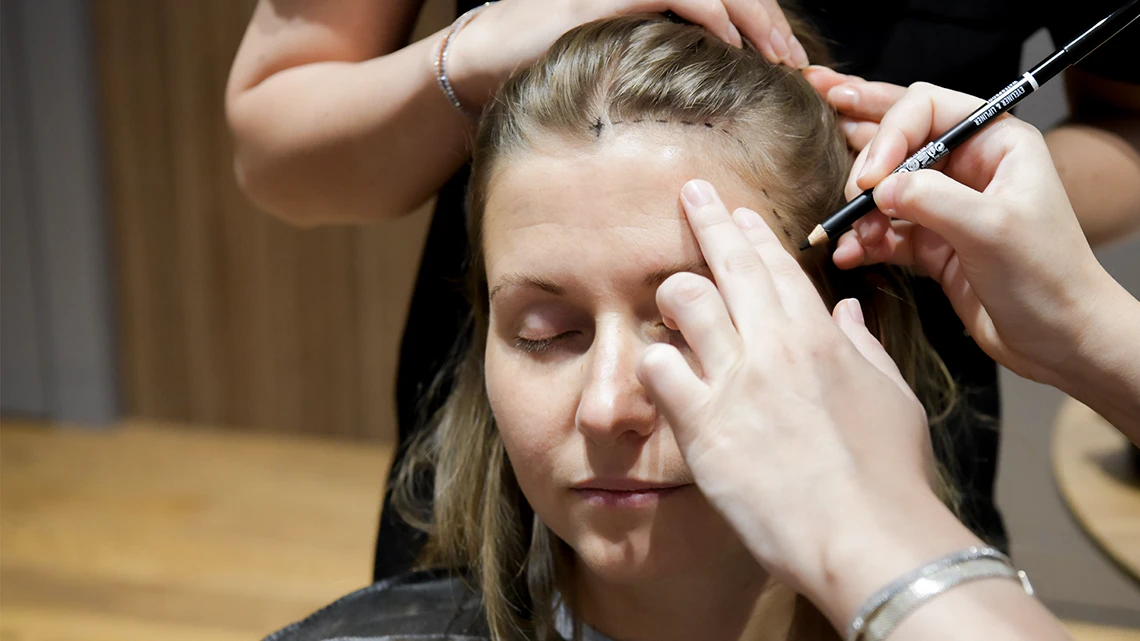Трансплантация на коса при жени in Turkey
A woman hair transplant in Turkey refers to a specialized hair restoration procedure tailored to address female pattern hair loss. Unlike male hair loss, which often presents as receding hairlines or bald spots, women typically experience diffuse thinning, especially at the crown and frontal regions. This distinction necessitates a more nuanced approach to ensure natural-looking results.

Woman Hair Transplant in Turkey: What is It?
Woman hair transplant in Turkey is a specialized procedure designed to restore hair density while preserving the natural hairline and feminine aesthetics. Unlike male hair transplants, women hair transplant in Turkey requires a more delicate approach due to differences in hair loss patterns and scalp characteristics. Women often experience diffuse thinning rather than complete baldness, making the transplantation process more complex. Surgeons carefully analyze the donor and recipient areas to ensure even distribution and a seamless blend with existing hair. The procedure typically involves advanced DHI techniques, allowing for precise follicle extraction and implantation without visible scarring.
Unlike traditional methods, a woman’s hair transplant is often performed without completely shaving the head, ensuring a more discreet healing process. This approach helps maintain the natural hairstyle while allowing for gradual hair growth and recovery. The implantation phase is crucial, as the surgeon must consider the natural direction and density of female hair patterns. Proper angulation of each follicle ensures that the new hair blends seamlessly and enhances overall volume. The procedure is tailored to each woman’s individual needs, providing a personalized solution for hair thinning or receding hairlines.
The recovery process for a woman’s hair transplant is generally smooth, with minor redness and scabbing that fade within a few days. Patients can return to daily activities relatively quickly while following post-operative care instructions for optimal results. New hair growth typically begins within a few months, gradually increasing in density and improving overall hair coverage.
How Does Hair Transplant for Women Differ from Men?
Hair transplant for women differs from men primarily in hair loss patterns, surgical approach, and the preservation of existing hair density. Women typically experience diffuse thinning rather than complete bald spots, requiring a more strategic implantation process. Unlike men, female patients often retain their frontal hairline, meaning the focus is on restoring volume rather than redesigning the hairline. The donor area in women is also more limited, as hair loss can be more widespread across the scalp. Surgeons carefully select healthy follicles to ensure even distribution and natural-looking results.
Unlike male hair transplants, women usually undergo the procedure without completely shaving their head, allowing for a more discreet healing process. This approach ensures that existing hair helps cover the treated areas while new follicles integrate naturally. The implantation phase requires precision, as the surgeon must match the natural direction and density of female hair growth. Proper angulation and spacing of the grafts prevent an unnatural appearance and enhance overall volume. Since women often seek to improve density rather than replace lost hair, the technique prioritizes subtle, seamless results.
Recovery for women is typically similar to men, but post-operative care focuses more on maintaining scalp health without disrupting existing hair. The healing process involves minimal redness and scabbing, which disappear within days, allowing for a quick return to daily activities. New hair growth begins within three to four months, gradually thickening over time for a fuller appearance. Full results are visible after a year as the transplanted hair blends seamlessly with the natural strands.
How Does a Women Hair Transplant Work?
A women’s hair transplant works by restoring hair density through the careful extraction and implantation of healthy follicles without shaving the entire scalp. The procedure begins with a consultation where the surgeon evaluates hair loss patterns and determines the best donor area for extraction. Unlike men, women usually experience diffuse thinning rather than bald patches, requiring a more strategic approach to follicle placement. Using the DHI technique, individual follicles are extracted from the donor area while preserving surrounding hair for a seamless blend. The surgeon then creates micro-incisions in the recipient area, ensuring proper angulation for a natural look.
Since women often retain their frontal hairline, the transplant focuses on increasing volume rather than reshaping the hairline. Each follicle is implanted carefully to match the natural growth pattern and density of existing hair. The procedure allows patients to maintain their original hairstyle, making the recovery process more discreet. Minimal redness and scabbing occur after the transplant, but these subside within a few days as healing progresses. Over the next few months, the transplanted follicles begin producing new hair, gradually improving thickness and overall coverage.
Which Transplantation Technique Should I Prefer?
Choosing the right technique for hair transplantation can vary depending on your personal needs, goals, and general health condition. Each technique has its own unique advantages and application areas. As Dr. Terziler Exclusive Clinic, we organize all your processes from health analyses to doctor consultation, ensuring that you have thick and healthy hair with the right method.
Sapphire FUE and Robotic DHI methods used in female hair transplantation are two advanced technologies developed to achieve both natural results and offer a minimally invasive process.
Robotic DHI Method
Robotic DHI (Direct Hair Implantation) is a technique where hair roots are placed directly into bald or thinned areas immediately after being taken from the donor area, without waiting. This method, which allows for a quick return to daily life due to being shaveless, is performed with a hair transplant robot patented by Dr. Terziler. Hair roots are placed at the most appropriate angle, depth, and direction, ensuring natural results.
Sapphire FUE Method
Sapphire FUE (Follicular Unit Extraction) is a technique where hair roots are taken one by one from the donor area and transplanted to thinned hair areas. Unlike traditional FUE, this method uses the world’s thinnest sapphire-tipped blades. Sapphire blades provide more precision in opening microchannels, accelerating the healing process and minimizing the risk of scarring. It is especially preferred to preserve the natural density of hair and achieve successful results in fine hair.
Both techniques are developed considering aesthetic concerns in female hair transplantation and are used to achieve natural and permanent results. Which one is more suitable can be decided based on the person’s hair structure, wishes, and doctor’s advice.
Can Women Get an Unshaven Hair Transplant?
Yes, women can get an unshaven hair transplant, allowing them to restore hair density without completely shaving their scalp. This method is ideal for female patients who want a discreet procedure while maintaining their existing hairstyle. Unlike traditional hair transplants, the unshaven technique only trims small sections of the donor area, leaving the rest of the hair intact. This approach ensures that surrounding hair conceals the treated areas, making the healing process less noticeable. It is particularly beneficial for women experiencing diffuse thinning rather than complete baldness.
The procedure follows the same steps as a standard DHI transplant but requires greater precision due to limited visibility. Surgeons carefully extract and implant follicles while ensuring natural density and seamless blending with existing hair. The unshaven technique is more time-consuming because the surgeon must navigate through long strands while preserving the natural hair structure. Since the scalp remains mostly untouched, women can continue styling their hair normally without revealing signs of the procedure. This technique provides a natural transition, allowing for gradual hair growth without a drastic change in appearance.
Why Choose Turkey for a Female Hair Transplant?
Choosing Turkey for a female hair transplant guarantees access to surgeons who specialize in the distinct anatomy and hormonal patterns of women’s hair. Clinics across the country have honed their techniques to address the finer, more delicate follicles typical of female hair, ensuring graft placement mimics natural density and direction.
Moreover, esteemed accreditation bodies recognize many Turkish clinics for their stringent safety and quality standards, reinforcing patient confidence in every aspect of treatment. If you’re seeking a female hair transplant experience that combines tailored expertise, cutting-edge technology, and complete care, contact our dedicated team today to schedule your complimentary consultation and discover how we can help you achieve beautifully natural results.
Who Is a Good Candidate for Hair Transplant as a Woman?
A good candidate for a hair transplant as a woman is someone who experiences persistent thinning or localized hair loss yet has a healthy donor area with sufficient follicle density.
Ideal candidates should also have a stable pattern of hair loss—meaning the shedding rate has plateaued for at least six months—so that transplanted grafts aren’t undermined by ongoing recession. Women whose hair loss stems from genetic factors, such as androgenetic alopecia, often benefit most, because the underlying cause won’t continue to erode the newly placed follicles.
Recovery Process After Woman Hair Transplant in Turkey
The recovery process after a woman undergoes a hair transplant in Turkey typically begins with a period of gentle post-operative care and progresses through staged healing and gradual hair regrowth over the ensuing months. During the first 48 hours, it’s essential to keep the head elevated and avoid touching or washing the transplanted area, as the newly placed grafts are still settling into the tiny recipient sites. This controlled environment minimizes swelling and helps the microscopic blood vessels reattach, securing graft survival.
In the following week, light cleaning with a specialized saline spray or mild shampoo is introduced to loosen any crusts without disturbing the follicles. At this stage, mild redness or scabbing is normal because the skin is repairing the micro-injuries caused by follicle implantation. Adhering to your clinic’s aftercare instructions—such as avoiding harsh sunlight, heavy exercise, and direct water pressure—ensures that inflammation remains low and the epidermis regenerates smoothly.
By the end of the first month, most of the initial transplanted hairs will shed as the follicles enter a resting phase—commonly known as “shock loss.” Although this may feel discouraging, it’s a natural part of the hair growth cycle: dormant follicles transition into the active growth stage (anagen) in the weeks that follow. During this interval, maintaining a balanced diet, staying hydrated, and following any prescribed supplements supports the follicles as they prepare to produce new shafts.
Is Hair Transplant Permanent for Women?
It’s important to understand that while transplanted hairs remain permanent, untreated areas may continue to thin over time if you have progressive hair-loss conditions. To maintain a harmonious overall look, many women combine transplantation with medical therapies or PRP treatments that strengthen surrounding follicles and slow future shedding. Regular follow-up appointments allow your specialist to monitor scalp health and recommend maintenance protocols as needed.
If you’re seeking a lasting solution to female pattern hair loss and wish to restore density where it matters most, our experienced team is here to guide you. Contact us today to schedule a complimentary consultation and discover a personalized plan that delivers natural, enduring results.
Do You Have To Shave Your Head For a Hair Transplant?
You don’t necessarily have to shave your head entirely to undergo a hair transplant. In many modern clinics, surgeons will only clip the donor area—the back and sides of your scalp—to a shorter length while leaving the recipient zone long enough to camouflage the procedure immediately afterward.
Some techniques, like “long-hair FUE,” allow patients to keep existing hair at its usual length, providing instant coverage and discretion. In these cases, the surgeon carefully extracts follicles from beneath the strands, so you can return to your daily life without obvious signs of surgery. However, this method can take longer and may be slightly more expensive, since it demands greater precision and extra time under the microscope.
Women Hair Transplant in Turkey Cost 2025
Female hair transplantation prices can vary depending on the chosen transplantation technique, the number of grafts to be planted, and additional services. A detailed consultation with an expert doctor provides the most accurate approach in determining personalized costs.
To get clear information about hair transplantation prices and receive an offer suitable for your personal situation, you can fill out the free form and have our clinic call you.














